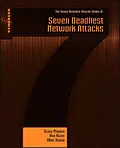Seven Deadliest Network Attacks identifies seven classes of network attacks and discusses how the attack works, including tools to accomplish the attack, the risks of the attack, and how to defend against the attack. This book pinpoints the most dangerous hacks and exploits specific to networks, laying out the anatomy of these attacks including how to make your system more secure. You will discover the best ways to defend against these vicious hacks with step-by-step instruction and learn techniques to make your computer and network impenetrable. The book consists of seven chapters that deal with the following attacks: denial of service; war dialing; penetration testing; protocol tunneling; spanning tree attacks; man-in-the-middle; and password replay. These attacks are not mutually exclusive and were chosen because they help illustrate different aspects of network security. The principles on which they rely are unlikely to vanish any time soon, and they allow for the possibility of gaining something of interest to the attacker, from money to high-value data. This book is intended to provide practical, usable information. However, the world of network security is evolving very rapidly, and the attack that works today may (hopefully) not work tomorrow. It is more important, then, to understand the principles on which the attacks and exploits are based in order to properly plan either a network attack or a network defense. Seven Deadliest Network Attacks will appeal to information security professionals of all levels, network admins, and recreational hackers. - Knowledge is power, find out about the most dominant attacks currently waging war on computers and networks globally - Discover the best ways to defend against these vicious attacks; step-by-step instruction shows you how - Institute countermeasures, don't be caught defenseless again, and learn techniques to make your computer and network impenetrable
Autorentext
Stacy Prowell is a senior member of the CERT technical staff, and chief scientist of STAR*Lab. He is an expert in the function-theoretic foundations of software, and is currently conducting research and development for function extraction technology. Prowell has managed both commercial and academic software development projects and consulted on design, development, and testing of applications ranging from consumer electronics to medical scanners, from small embedded real-time systems to very large distributed applications.
Prior to joining the SEI in 2005, Prowell was a research professor at the University of Tennessee. To support wider adoption of rigorous methods in industry, he started the Experimentation, Simulation, and Prototyping (ESP) project at the University of Tennessee, which develops software libraries and tools to support application of model-based testing and sequence-based specification. Software developed by this program is in use by over 30 organizations. Prior to working at the university, he served as a consultant in the software industry. His research interests include rigorous software specification methods, automated statistical testing, and function-theoretic analysis of program behavior. Prowell holds a PhD in Computer Science from the University of Tennessee and is a member of the ACM, IEEE, and Sigma Xi.
Klappentext
Seven Deadliest Network Attacks identifies seven classes of network attacks and discusses how the attack works, including tools to accomplish the attack, the risks of the attack, and how to defend against the attack. This book pinpoints the most dangerous hacks and exploits specific to networks, laying out the anatomy of these attacks including how to make your system more secure. You will discover the best ways to defend against these vicious hacks with step-by-step instruction and learn techniques to make your computer and network impenetrable.
The book consists of seven chapters that deal with the following attacks: denial of service; war dialing; penetration testing; protocol tunneling; spanning tree attacks; man-in-the-middle; and password replay. These attacks are not mutually exclusive and were chosen because they help illustrate different aspects of network security. The principles on which they rely are unlikely to vanish any time soon, and they allow for the possibility of gaining something of interest to the attacker, from money to high-value data. This book is intended to provide practical, usable information. However, the world of network security is evolving very rapidly, and the attack that works today may (hopefully) not work tomorrow. It is more important, then, to understand the principles on which the attacks and exploits are based in order to properly plan either a network attack or a network defense.
Seven Deadliest Network Attacks will appeal to information security professionals of all levels, network admins, and recreational hackers.
- Knowledge is power, find out about the most dominant attacks currently waging war on computers and networks globally
- Discover the best ways to defend against these vicious attacks; step-by-step instruction shows you how
- Institute countermeasures, don't be caught defenseless again, and learn techniques to make your computer and network impenetrable
Inhalt
Introduction Chapter 1. Denial of Service Chapter 2. War Dialing Chapter 3. Penetration "Testing" Chapter 4. Protocol Tunneling Chapter 5. Spanning Tree Attacks Chapter 6. Man-in-the-Middle Chapter 7. Password Replay
